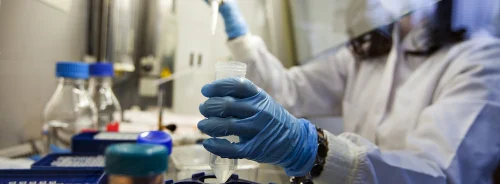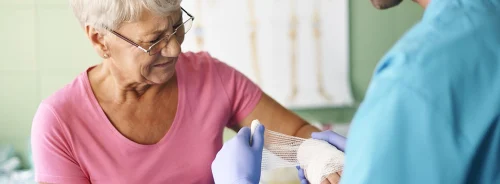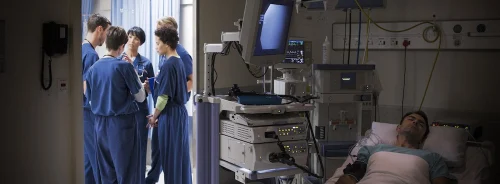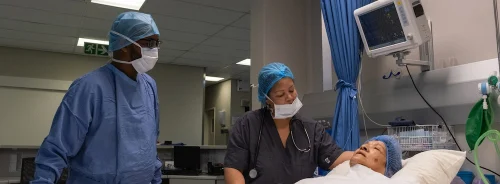ICU Management & Practice, Volume 16 - Issue 3, 2016
Ventilator-associated pneumonia is a major complication of mechanical ventilation and represents the most common reason for antibiotic prescription in ventilated patients. Incidence ranges from 1.2 to 8.5 cases per 1000 ventilator days or 9 to 27% cases per mechanically ventilated patient; attributable mortality rates vary between 0% and 70% (Chastre and Fagon 2002; Melsen et al. 2013). The large variability of these figures stems from the fact that both development and outcome of VAP result from a complex interplay between pathogens and host under the influence of many factors: comorbidities, severity and cause of the underlying critical illness, its treatment and its evolution over time. Additionally, uncertainty surrounds diagnosis of VAP and many different diagnostic strategies and criteria prevail. Clinical signs and symptoms, biochemical markers of inflammation and radiological signs of alveolar consolidation, which are highly accurate for a diagnosis of pneumonia in a walking patient in the community are much less so in the critically ill patient under mechanical ventilation. Clinical and biochemical alterations may be absent, or may have an alternative cause that can be infectious or non-infectious. An infiltrate on chest x-ray is required for diagnosis, as it has high sensitivity, but is remarkably non-specific. Inter-observer variability of chest x-ray interpretation is large, especially when it comes to deciding whether or not an infiltrate is ‘new’, ‘evolving’ and represents alveolar consolidation. Increasing the number of diagnostic criteria required for diagnosis gains specificity at the cost of reduced sensitivity. The Clinical Pulmonary Infection Score (CPIS) is a quantification of these criteria in a summary score: a higher CPIS score increases the likelihood that VAP is present, but no single cut-off combining a high sensitivity with a high or acceptable specificity can be identified (Schurink et al. 2004). Despite decades of study and an impressive amount of published data, the question of how VAP can be accurately diagnosed is not definitively settled. In this contribution, four controversies regarding VAP diagnosis are briefly discussed.
Invasively Obtained Microbiology Allows Accurate Diagnosis of VAP
Adding microbiological data increases specificity of VAP diagnosis (Chastre and Fagon 2002). However, the presence of a potential pathogen in a respiratory sample of a mechanically ventilated patient is in itself no proof for VAP, as it may represent colonisation of lower respiratory airways or contamination by flora residing in the upper respiratory tract or in the biofilm on the endotracheal tube. Invasive diagnostics in VAP refer to the use of fiberoptic or blind bronchoalveolar lavage or protected specimen brush in order to sample more selectively the distal airways and alveoli. Using these samples for direct examination for the presence of intracellular pathogens in alveolar macrophages or polymorphonuclears and for quantitative culturing further helps to distinguish between colonisation and infection (Chastre and Fagon 2002; Torres et al. 1996; Pugin et al. 1991). As such, quantitative cultures of invasively obtained samples may improve the specificity of VAP diagnosis more than qualitative culture of routinely obtained endotracheal aspirates. However, the selection of a threshold for quantitative cultures to discriminate between infection and colonisation again must strike a balance between specificity and sensitivity. Thresholds for diagnosing VAP may differ between populations. For example, some authors have argued in favour of using a higher threshold (>105 colony-forming units (CFU)/ ml) in bronchoalveolar lavage (BAL) samples of trauma patients than the one usually applied in medical patients (>104 CFU/ml, to reduce the number of false positives (Croce et al. 2004). On the other hand, in patients who received antibiotics prior to their BAL, the quantitative threshold for VAP diagnosis should probably be lowered to limit the number of false negatives. However, in the absence of a true gold standard for the diagnosis of VAP, test characteristics of invasive microbiological techniques are not well established. Quantitative cultures themselves are often used as a form of gold standard to which other diagnostic tests are compared, which may lead to a form of circular reasoning (Pugin et al. 1991). Regardless of the higher specificity of invasive microbiology, clinical characteristics must always be taken into account for a diagnosis of VAP, as many patients with prolonged mechanical ventilation have a high burden of bacteria in the lower airways without signs of infection (Baram et al. 2006).
Invasively Obtained Microbiology Improves Outcome in VAP
Proponents of invasive diagnostic strategies in VAP have argued that these techniques improve patient outcome. The outcome benefit is attributed to the higher diagnostic specificity, which helps the attending physician to avoid unnecessary antibiotics and/or direct a search for alternative diagnosis if VAP is refuted (Fagon et al. 2000). In a recent study, diagnostic workup of clinically suspected VAP with invasively obtained quantitative cultures below threshold led to an alternative diagnosis in 60% of cases (Schoemakers et al. 2014). Proponents of noninvasive diagnostics state that the main treatment factor influencing outcome is timely and appropriate empirical antibiotic therapy directed at all likely involved pathogens; microbiological data serve only to guide subsequent de-escalation of antibiotics. For this purpose, routine endotracheal samples and semi-quantitative cultures may suffice (Canadian Critical Care Trials Group 2006). In this view, invasive sampling adds little benefit for the patient and has the disadvantage of increased costs and potentially delayed effective therapy. A meta-analysis comparing invasive and noninvasive strategies for VAP diagnosis found no difference in outcome (Shorr et al. 2005), but this has not settled the controversy. Recently, the need for antibiotic stewardship measures in VAP management has revived the discussion. Identification of the causal pathogen of VAP has been identified as the main factor promoting de-escalation of empirical antibiotics. As invasively obtained microbiological cultures are more likely to represent the true causal pathogens of VAP compared to cultures from noninvasive samples, the physician may be given greater confidence to de-escalate. Giantsou et al. (2007) indeed found higher de-escalation rates in patients subjected to BAL instead of endotracheal aspirates. In addition, the higher specificity of quantitative cultures in suspected VAP, translating into fewer false positives, would also lead to fewer unnecessary antibiotic treatments (Sharpe et al. 2015). However, in the Canadian Critical Care Trials Group trial, which randomised between an invasive and a noninvasive strategy for VAP diagnosis, no differences in the rate of de-escalation or antibiotic stop were found between both arms, nor was patient outcome different (Canadian Critical Care Trials Group 2006). In addition, increased focus on antibiotic stopping whenever possible, using repeated clinical evaluations (Micek et al. 2004; Singh et al. 2000), or a protocol guided by sequential procalcitonin measurements (De Jong et al. 2016) may achieve a major effect without the use of invasive microbiology.
See Also:Nosocomial Pneumonia
Ventilator-Associated Tracheobronchitis (VAT) is a Separate Condition of VAP
The observation that patients may have all clinical signs and symptoms of VAP and respond to the microbiological criteria of VAP in the absence of unambiguous infiltrates on chest x-ray has led to the concept of ventilator-associated tracheobronchitis (VAT). VAT represents a more limited infection of the lower respiratory tract in ventilated patients. The association between VAT and mortality is less obvious than in VAP, yet VAT appears to be associated with a longer duration of mechanical ventilation (Nseir et al. 2005). It is not clear whether VAT represents a precursor or early stage of VAP, i.e. whether untreated it proceeds to VAP, or whether it is a milder stage of infection, sitting in the continuum between lower respiratory tract colonisation and clear-cut VAP (Rouby et al. 1992). Moreover, as the absence of a new or worsening infiltrate on chest x-ray makes the only distinction between VAT and VAP, inter-observer variability may lead to false classification of VAP as VAT. VAT may progress to VAP in a third of cases (Dallas et al. 2011); antibiotic treatment of VAT thus may prevent evolution to VAP in some patients but may not influence outcome in others. Given the necessity to restrict antibiotics as part of antibiotic stewardship, treatment of VAT is not straightforward. Antibiotic therapy in VAT, e.g. as delivered by inhalation (Palmer et al. 2008) or systemically as a short course (Nseir et al. 2008), may prevent full VAP and thus have an overall antibiotic-sparing effect. On the other hand, a strategy in which VAT routinely is considered as an indication for antibiotic therapy will increase the number of antibiotic prescriptions in patients who will not directly benefit from it, but still are exposed to the harmful effects of antibiotics, especially increased selection pressure.
Ventilator-Associated Events (VAE) Are a Better Concept for Monitoring of Quality of Intensive Care
The lack of accuracy of diagnostic criteria of VAP, and especially the inter-observer variability of chest x-ray interpretation hampers the use of VAP as a quality indicator for benchmarking intensive care unit (ICUs). Ego et al. (2015) found that VAP incidence in their ICU population varied tremendously according to the different sets of diagnostic criteria used. Reports about achieving zero VAP rates may thus reflect the use of overly specific (and too little sensitive) diagnostic criteria rather than true absence of VAP. This has led to a radical change in the Centers for Disease Control and Prevention (CDC) approach to surveillance of complications of mechanical ventilation, dismissing subjective criteria (such as chest x-ray interpretation) and broadening the concept of VAP to that of ventilator-associated events (VAE). VAE refers to a respiratory deterioration of a mechanically ventilated patient after initial improvement and stabilisation, and is diagnosed on the basis of more objective criteria such as ventilator settings and oxygenation indices: this deterioration may or may not be due to infection. A new definition of VAP is tied within this framework and is defined as VAE together with signs of inflammation or newly started antibiotics, purulent secretions and presence of pathogens in respiratory cultures: the label ‘possible VAP’ and ‘probable VAP’ is applied if only one, and two respectively, of the last two criteria are met. Studies have shown that VAE poorly correlate with ‘traditionally diagnosed’ VAP (Klein Kouwenberg et al. 2013): less severe VAP is missed by VAE and a large number of VAE are not due to VAP. On the other hand, Bouadma et al. (2015) found a good correlation between VAE and antibiotic consumption in their multicentre OUTCOMEREA database, suggesting that VAE could represent a proxy for true VAP. Whether or not VAE is preventable is a matter of discussion (Klompas et al. 2015); this is however a cardinal prerequisite for its use as a quality indicator.
Conflict of Interest
Pieter Depuydt declares that he has no conflict of interest. Liesbet De Bus declares that she has no conflict of interest.
Abbreviations
BAL bronchoalveolar lavage
CFU colony-forming unit
CPIS Clinical Pulmonary Infection Score
ICU intensive care unit
VAE ventilator-associated event
VAP ventilator-associated pneumonia
VAT ventilator-associated tracheobronchitis
References:
Baram D, Hulse G, Palmer LB (2005) Stable patients receiving prolonged mechanical ventilation have a high alveolar burden of bacteria. Chest 127(4): 1353-7.
PubMed ↗
Bouadma L, Sonneville R, Garrouste-Orgeas M et al. (2015) Ventilator-associated events : prevalence, outcome, and relationship with ventilator-associated pneumonia. Crit Care Med, 43(9): 1798-806.
PubMed ↗
Canadian Critical Care Trials Group et al. (2006) A randomized trial of diagnostic techniques for ventilator-associated pneumonia. N Engl J Med, 355(25): 2619-30.
PubMed ↗
Chastre J, Fagon JY (2002) Ventilator-associated pneumonia. Am J Respir Crit Care Med, 165(7): 867-903.
PubMed ↗
Croce MA, Fabian TC, Mueller EW et al. (2004) The appropriate diagnostic threshold for ventilator-associated pneumonia using quantitative cultures. J Trauma, 56(5): 931-4.
PubMed ↗
Dallas J, Skrupky L, Abebe N et al. (2011) Ventilator-associated tracheobronchitis in a mixed surgical and medical ICU population. Chest, 139(3): 513-8.
PubMed ↗
de Jong E, van Oers JA, Beishuizen A et al. (2016) Efficacy and safety of procalcitonin guidance in reducing the duration of antibiotic treatment in critically ill patients: a randomised, controlled, open-label trial. Lancet Infect Dis, 16(7): 819-27.
PubMed ↗
Ego A, Preiser JC, Vincent JL (2015) Impact of diagnostic criteria on the incidence of ventilator-associated pneumonia. Chest, 147(2): 347-55.
PubMed ↗
Fagon JY, Chastre J, Wolff M et al. (2000) Invasive and noninvasive strategies for management of suspected ventilator-associated pneumonia: a randomized trial. Ann Intern Med, 132(8): 621-30.
PubMed ↗
Giantsou E, Liratzopoulos N, Efraimidou E et al. (2007) De-escalation therapy rates are significantly higher by bronchoalveolar lavage than by tracheal aspirate. Intensive Care Med, 33(9): 1533-40.
PubMed ↗
Klein Kouwenberg PMC, Van Mourik MSM, Ong DSY et al. (2013) Validation of a novel surveillance paradigm for ventilator-associated events. Crit Care, 17(Suppl 4).
Article ↗
Klompas M (2012) Is a ventilator-associated pneumonia rate of zero really possible? Curr Opin Infect Dis, 25(2): 176-82.
PubMed ↗
Klompas M, Anderson D, Trick W et al. (2015) The preventability of ventilator-associated events. The CDC Prevention Epicenters Wake up and Breathe Collaborative. Am J Respir Crit Care Med; 191(3): 292-301.
PubMed ↗
Melsen WG, Rovers MM, Groenwold RH et al. (2013) Attributable mortality of ventilator-associated pneumonia: a meta-analysis of individual patient data from randomised prevention studies. Lancet Infect Dis, 13(8): 665-71.
PubMed ↗
Micek ST, Ward S, Fraser VJ et al. (2004) A randomized controlled trial of an antibiotic discontinuation policy for clinically suspected ventilator-associated pneumonia. Chest, 125(5): 1791-9.
PubMed ↗
Nseir S, Di Pompeo C, Soubrier S et al. (2005) Effect of ventilator-associated tracheobronchitis on outcome in patients without chronic respiratory failure: a case-control study. Crit Care, 9(3): R238-45.
PubMed ↗
Nseir S, Favory R, Jozefowicz E et al. (2008) Antimicrobial treatment for ventilator-associated tracheobronchitis: a randomized, controlled, multicenter study. Critical Care, 12(3): R62.
PubMed ↗
Palmer LB, Smaldone GC, Chen JJ et al. (2008) Aerosolized antibiotics and ventilator-associated tracheobronchitis in the intensive care unit. Crit Care Med, 36(7): 2008-13.
PubMed ↗
Pugin J, Auckenthaler R, Mili N et al. (1991) Diagnosis of ventilator-associated pneumonia by bacteriologic analysis of bronchoscopic and non-bronchoscopic “blind” bronchoalveolar lavage fluid. Am Rev Respir Dis, 143(5 Pt 1): 1121-9.
PubMed ↗
Rouby JJ, Martin de Lassale E, Poete P et al. (1992) Nosocomial bronchopneumonia in the critically ill. Am Rev Respir Dis, 146(4): 1059-66.
PubMed ↗
Schoemakers RJ, Schnabel R, Oudhuis G et al. (2014) Alternative diagnosis in the putative ventilator-associated pneumonia patients not meeting lavage-based diagnostic criteria. Scand J Infect Dis, 46(12): 868-74.
PubMed ↗
Schurink C, Van Nieuwenhoven CA, Jacobs JA et al. (2004) Clinical pulmonary infection score for ventilator-associated pneumonia: accuracy and inter-observer variability. Intensive Care Med, 30(2): 217-24.
PubMed ↗
Sharpe JP, Magnotti LJ, Weinberg JA et al. (2015) Adherence to an established diagnostic threshold for ventilator-associated pneumonia contributes to low false-negative rates in trauma patients. J Trauma Acute Care Surg, 78(3): 468-73.
PubMed ↗
Shorr AF, Sherner JH, Jackson Wl et al. (2005) Invasive approaches to the diagnosis of ventilator-associated pneumonia: a meta-analysis. Crit Care Med, 33(1): 46-53.
PubMed ↗
Singh N, Rogers P, Atwood CW et al. (2000) Short-course empiric antibiotic therapy for patients with pulmonary infiltrates in the intensive care unit: a proposed solution for indiscriminate antibiotic prescription. Am J Respir Crit Care Med, 162(2 Pt 1): 505-11.
PubMed ↗
Torres A, El-Ebiary M, Fábregas N et al. (1996) Value of intracellular bacteria detection in the diagnosis of ventilator associated pneumonia. Thorax, 51(4): 378-84.
PubMed ↗








